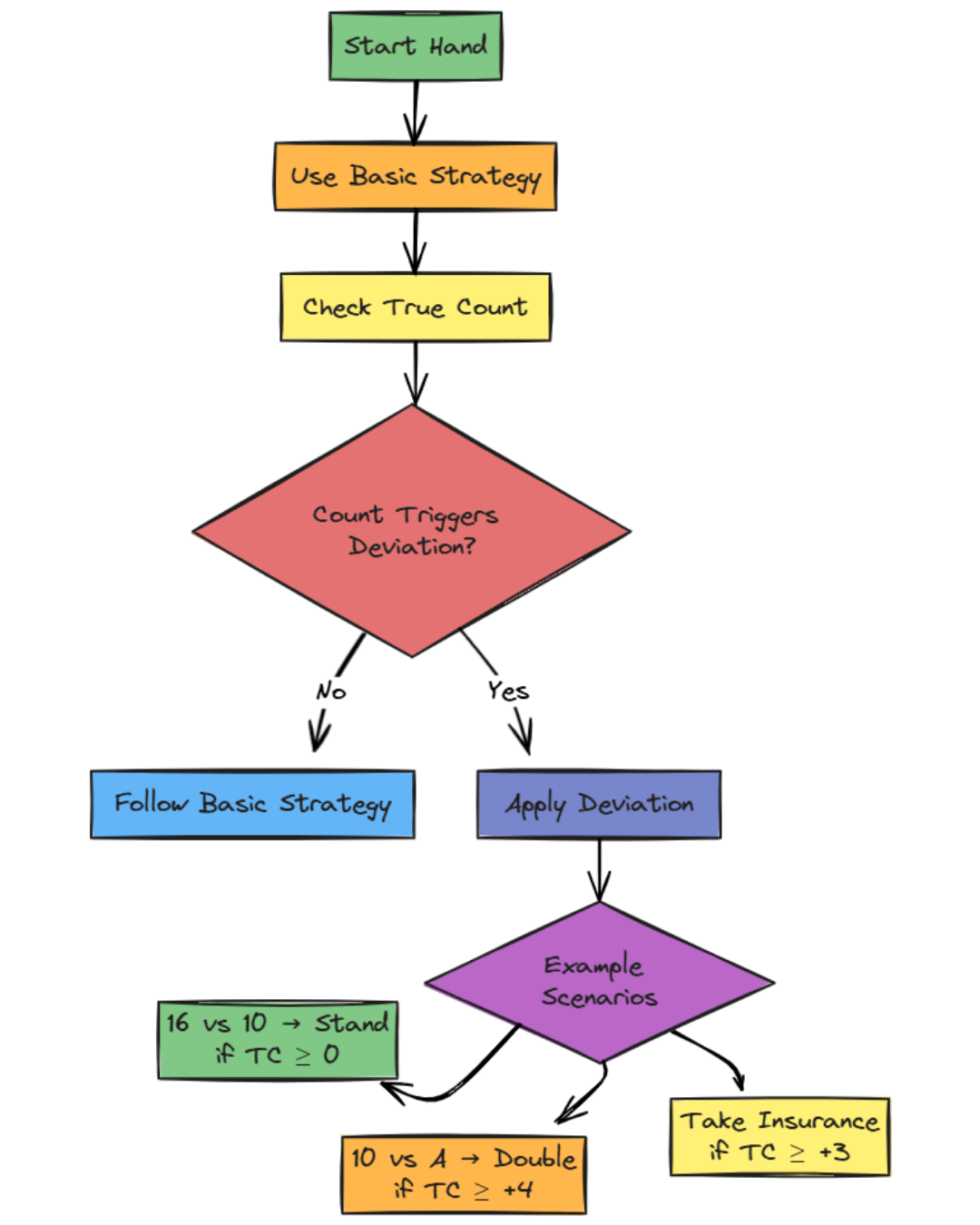Blackjack Deviations: A Down-to-Earth Guide
Table Of Content
If you’ve ever mastered basic strategy in blackjack and thought, “Okay, I’ve got this game figured out”—well, hang on a second. There’s another layer you haven’t touched yet. That’s where blackjack deviations come in.
Now, don’t let the word “deviations” scare you. It sounds like something from a math class you didn’t want to take. But in reality? It’s a simple (and powerful) tool for serious players. And if you’re already counting cards—or planning to start—understanding when to deviate from basic strategy can mean the difference between winning and just breaking even.
What Are Blackjack Deviations?
So, what exactly are blackjack deviations? In simple terms, they’re specific plays where you don’t follow basic strategy because the count tells you something has changed.
Basic strategy assumes a balanced shoe. But if you’re counting cards and know there are more high cards left in the deck than low ones (or vice versa), some decisions need to shift. That’s where playing deviations in blackjack come into play.
Let’s say you’ve got a 12 against the dealer’s 3. Basic strategy says, “Stand.” But if the count is high enough, that same hand becomes a “Hit.” Why? Because more 10s in the deck increase the chance of the dealer busting—but also your risk if you don’t hit. And the numbers show that hitting becomes the better move under certain conditions.
So yeah—it’s all about adjusting to the situation based on the count.
Why Do Blackjack Card Counting Deviations Matter?
Once you’re counting cards, you’ve already reduced the house edge. But if you want to go from being a good player to a dangerous one (in a good way), you need to layer in these deviations.
Here’s the thing: casinos know about card counting. They’re watching for bet spreads, mid-shoe entries, all of it. But most players—even counters—don’t apply blackjack card counting deviations consistently. That’s your edge.
You don’t need to memorize 100 deviations. You only need to know the important ones—the ones that actually move the needle.
The Illustrious 18: The Top Blackjack Deviations
If you’re wondering, “How many blackjack deviations are there?” the full list is long. But experts have narrowed down the most impactful ones to what’s known as the Illustrious 18.
This is the go-to list for card counters. It includes situations like:
- Insurance if the true count is +3 or higher
- 16 vs 10, hit or stand depending on the count
- 15 vs 10, another one that changes often
- 12 vs 3 blackjack and blackjack 12 vs 2 – these are small hands, but the decisions can swing your long-term edge
Now, this isn’t just theory. I’ve had sessions where knowing to hit a 16 against a 10 because the count was high enough saved my stack. And yes, it feels weird going against the book at first—but once you understand the math, it clicks.
Blackjack Deviations Chart: H17 vs S17
Here’s a detail a lot of players miss: blackjack deviations aren’t universal. The correct play can depend on the rules of the table, especially whether the dealer hits or stands on soft 17.
- In H17 (dealer hits on soft 17), certain plays—like doubling on soft hands—become less favorable.
- In S17 (dealer stands on soft 17), some deviations shift because the dealer busts slightly more often.
That’s why you’ll sometimes see a blackjack deviations chart H17 or S17 listed separately. If you’re playing in multiple casinos, it’s worth having both versions handy—or at least understanding the key differences.
How to Memorize Blackjack Deviations Without Going Nuts
Let’s be real—memorizing stuff isn’t everyone’s favorite thing. I get it. But how to memorize blackjack deviations doesn’t have to mean grinding flashcards for hours.
Here’s what I tell new players:
- Start with the Illustrious 18. Seriously, just these will cover 90% of what you need.
- Group similar plays. For example, all the “vs 10” hands (12, 13, 14, 15, 16) behave similarly depending on the count. If you learn the pattern, it’s easier.
- Practice while playing online. Use low-stakes tables to test yourself in real time. You’ll remember more under pressure than staring at a chart.
- Create your own blackjack deviations list. Customize it based on the games you play most. If you only play S17 tables, there’s no point studying deviations for H17.
Eventually, these plays become second nature. You’ll glance at your count, look at the dealer’s upcard, and just know the right move.
Download Blackjack Deviations Chart

FAQs
1. How many blackjack deviations are there?
There are dozens, but the most important are called the Illustrious 18. These are the high-impact decisions that serious players memorize and use consistently.
2. Do I need to be a card counter to use deviations?
Yes, deviations are based on the true count, which requires card counting. Without knowing the count, you won’t have the right information to determine when to adjust your play.
3. Is it worth learning blackjack deviations if I’m just a casual player?
If you’re not counting cards, not really. But if you’re into card counting—even a little—then yes. Deviations give you the edge that makes counting actually profitable.



